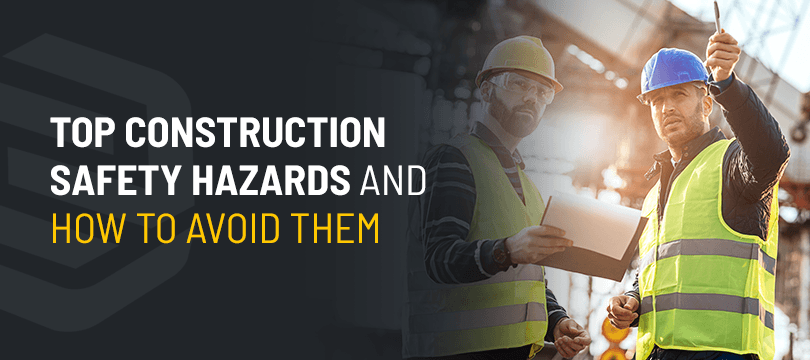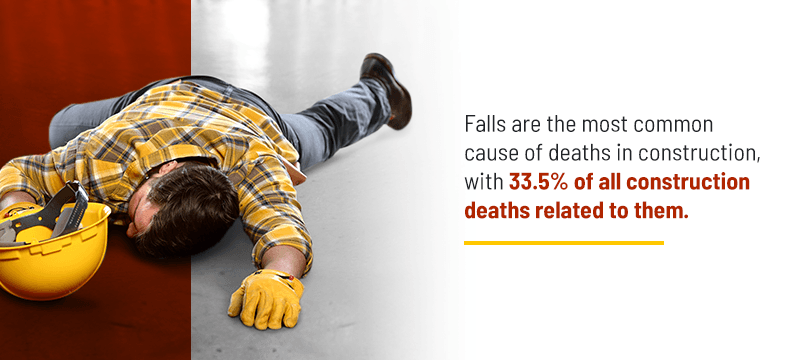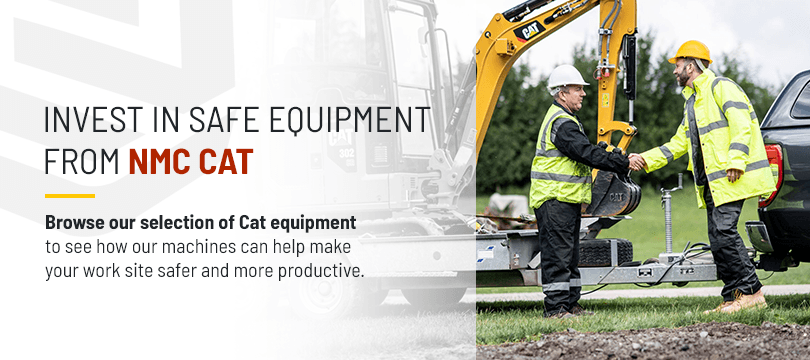
Top Construction Safety Hazards and How to Avoid Them
Category: Equipment and Solutions
According to the Occupational Safety and Health Administration (OSHA), there were 1,008 deaths in the construction industry in 2018. Out of all worker deaths in America, one in five is construction related. Of these construction deaths, more than half of them resulted from four leading causes: falls, being struck by an object, electrocutions and being caught in or between objects.
To better protect your employees, you may be interested in learning more about the primary construction industry hazards and ways you can prevent them.
Major Construction Hazards and How to Prevent Construction Accidents
Construction hazard prevention is a top priority for companies wanting to keep their workforce safe and ensure workers aren’t out for long periods due to injuries. As companies look to make their work sites safer, they often begin by identifying main hazards. Then, they can take steps to minimize the danger. Learn more about the four leading causes of fatalities and how to avoid construction hazards below:

1. Trips and Falls
Falls are the most common cause of deaths in construction, with 33.5% of all construction deaths related to them. Many construction workers have to work at high elevations on scaffolding. When workers don’t pay attention to their surroundings or scaffolding is set up improperly, there’s an increased chance that workers fall from these heights, potentially injuring themselves or even dying.
Any construction safety tips should identify ways you can reduce the risk of workers falling from scaffolding. Reducing fall deaths starts with ensuring the person assigned to designing, building and disassembling the scaffolding is well-trained and knows the importance of the tasks. Companies can also institute a policy that makes inspecting the scaffolding an everyday practice.
Scaffolding should always be erected on solid and level footing to ensure workers can keep their balance. Additionally, scaffolding should:
- Be stationed a minimum of 10 feet away from power lines.
- Have mid-rails, toeboards and guardrails installed.
- Be planked and decked as much as possible.
Trips and falls may result in injury and death, especially if a trip occurs near heavy-duty machinery, at a high-elevation or close to electrical hazards. Common culprits that cause trips and falls are unused materials left at work sites, distracted workers and uneven terrain.
To reduce the chances of tripping and falling, it’s important for crews to make sure unused materials aren’t left in pathways and uneven terrain is identified. Companies can also prioritize fall protection practices. For example, workers who have to walk on surfaces 6 feet or higher above a lower level should have fall protection systems. Effective fall prevention products include personal fall arrest systems, guardrails and safety net systems.
2. Struck by Object
The second most common cause of death in the construction injury is workers being struck by objects. In 2018, struck by objects accounted for 11.1% of deaths in the construction industry. As you might expect, construction work sites are filled with materials and equipment that could be incredibly dangerous if dropped on a worker. Injuries and death may come from falling beams, materials or tools hitting workers.
There are a few safety protocols a company can implement to protect workers from falling objects. A simple practice to implement and follow is ensuring everyone at the work site wears their hard hat at all times. Workers who operate machinery should also know never to exceed their machine’s max load. Exceeding the max load can cause the equipment to break and drop the material it’s transporting onto workers.
Another safety measure companies can implement is installing safety net systems around areas where objects are likely to fall. Instituting a monitoring safety system can help as well. In this system, a safety monitor reviews the work site and identifies fall hazards, communicating their findings to workers.
Workers can also wear high-visibility clothing to lower the chances of objects and debris being thrown onto an unsuspecting worker. It’s important for staff to know never to put themselves in a position where they’re stuck between fixed and moving objects.
3. Electrocutions
One of the major construction site hazards is electrocution, with approximately 8.5% of construction worker deaths attributed to it every year. While companies and workers are aware electricity can be dangerous, some electrical hazards aren’t always apparent. Some of the most common sources of electrical risk come from the following:
- Untrained staff assigned to electrical tasks
- Employees working too close to power lines
- Lack of coordination
- Underground or overhead cables
Injury and death most often occur when a worker makes direct contact with live parts or when they touch a conducting material or object inadvertently. Even though most construction companies take time to mark the locations of unfinished electrical systems, power lines or exposed wiring, there are further steps they can take for the safety of their workers.
A crucial step to take is outfitting staff with hard hats, which can protect workers from electrical hazards. If a hard hat suffers an electric shock, it should be replaced immediately. Additionally, when workers operate portable electric tools, they should always be double insulated or grounded.
It’s vital to prioritize finding all live conductors and making them extremely visible to anyone on the site. Any workers who are expected to perform electrical tasks must have in-depth training to ensure they know proper safety practices.
4. Caught-In or Between
The fourth most common cause of death is caught-in or between incidents. In 2018, 5.5% of workers were killed due to being compressed by or caught in equipment or objects. These deaths also include those where employees were crushed, caught or struck by collapsing materials, equipment or structures.
To prevent caught-in or between deaths, many companies institute a policy stopping workers from entering an unprotected excavation or trench 5 feet or deeper without safety equipment and a protective system installed. While working in excavations or trenches, workers should also be protected with benching, shoring, trench shield systems or sloping.
Companies can reduce the chances of caught-in or between deaths by ensuring every piece of equipment on the work site has guards in place. Workers should also be aware of the crush points and pull-in areas of a piece of equipment. Companies can also train their workers to be more aware of their environment and more mindful while they complete their daily tasks.
Invest in Safe Equipment from NMC Cat
If you’re pursuing the best ways to protect your company from common hazards, you may be interested in safety equipment to reduce injuries at your work site. You want equipment that reduces the chances of dropped materials and offers precise handling in areas filled with people. Accordingly, you may want to invest in high-quality, safe Cat® equipment from NMC Cat.
Browse our selection of Cat equipment to see how our machines can help make your work site safer and more productive. Have any questions? Contact us today.

